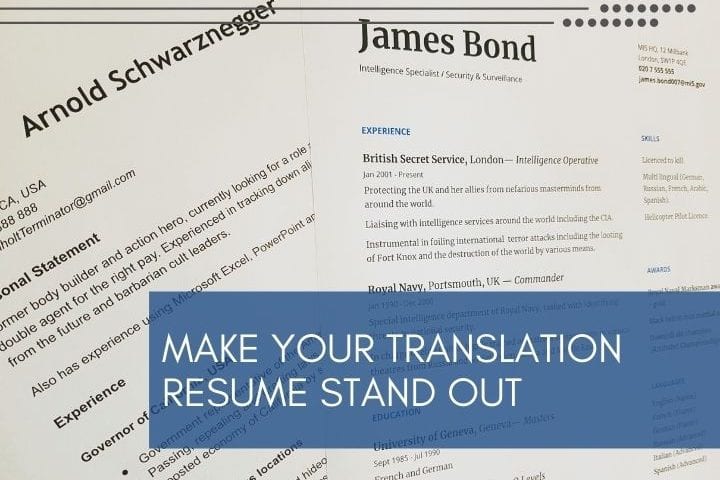
Episode 267: How to Market Interpreting Services During a Pandemic – Interview with Troublesome Terps
02/01/2021
Episode 268: Website Localization as a Specialization – Tips and Tricks – Interview with Dorota Pawlak
02/15/2021When was the last time you reviewed your resume or professional profile? Are you sure it portrays your services in the best light for potential translation buyers?
Your resume or professional profile is a living document. Many translators google “resume for translators” and follow the templates that show up in the results. But these are often created by career advisors, not familiar with the translation industry, and I have noticed a lot of things that can go wrong. So how can we improve them?
Your resume needs to be impeccable, concise, and informative enough to help it stand out amongst the clutter to succeed. Here are some tips.
WHAT SHOULD A TRANSLATOR RESUME OR PROFILE INCLUDE?
If you want your resume to stand out from the crowd, you need to make sure it presents you in the best light. Here are some things to make sure you include in your resume.
Your Language Pair(s)
Indicate your language pair(s) visibly and clearly in your headline so that the reader does not have to scroll to the bottom of the page to determine what languages you translate. However, you do not need to add the standard terms of fluency, reading, writing, etc. These things are a given. Instead, indicate your native language since most agencies and customers only want translators that translate into their native language. The only exception is if you are completely bilingual.
Your Area(s) of Specialization
The next thing a vendor manager or client will look for is your area of specialization. Your resume should clearly state your industry along with any specializations. Are you a legal translator, an interpreter, or are you focusing on tourism, marketing pharmaceuticals…?
Whether you are an experienced translator, or just starting out, try not to be too general in your resume. Strive to narrow your focus so you can draft a more compelling resume. Writing that you specialize in 8 or more fields will lower your credibility.
Very few agencies or companies will look for a generalist, especially now that machine translation is improving fast. They prefer to assign projects to translators who have at least a general area of specialization. The same goes for direct clients. They want to know that you understand them and their products and services well.
Choose a few areas to focus on so you can create a few versions of your resume to state who you are and what you do clearly.
Both the languages and the area(s) of specialization can be part of the header in your resume.
Summary/Personal Statement
This is a few sentences under your name and headline. Here you can write a summary of your experience and the services you provide. For example:
“I’ve been a translator for X number of years, specializing in XXX (area(s) of specialization). I provide the following services: (For example, translation, editing, proofreading, consecutive interpreting, simultaneous interpreting, transcreation, website localization, iSEO…) I help (types of companies) with (their problems) so that (solutions).”
If you don’t have any experience, say so in a positive way. For example:
“I recently graduated from XXX, and I am currently building up my experience in the field of professional translation. I am currently gaining experience in XXX by (volunteering, working in-house, etc.) and working with my mentor/proofreader to improve my skills. I am passionate about X and Y (subjects)…”
Experience
Use this section to list your translation experience. Be as specific as possible.
Example: Translator for Optimize Medical – clinical trials 100,000 words (or the number of years), EMA Templates for EU, etc.
Group projects by areas of expertise and list the types of projects you have the most experience in or enjoy working with the most (instead of every kind of project you have done). Remember not to list products or companies if you have signed a Non-Disclosure Agreement.
If you have other work experience related to your linguistic career, it is good to list this here. Previous experience as a language teacher, a marketing manager, a researcher, or a tourist guide could easily prove useful to a freelance translator. However, don’t include work experience that has nothing to do with the linguistic industry.
If you don’t have experience, try to get some. Several volunteer associations need translators, for example, Translators Without Borders or Kiva. Here is a list of websites for volunteer translators.
Education
This is where you list all your relevant education. If you are a recent graduate with a degree in translation or interpretation, you might list this first.
Example: Bachelor of Arts in translation – University – Year. Or, MBA – University, Year
Even if you have a degree not related to translation or interpretation, you should add it here. A degree in any field shows that you have a good education and have gained research skills. This is especially beneficial if you specialize in the area of your education; for example, I have a degree in marketing and specialize in marketing.
Certifications and Continuing Education
If you have any certifications, list them prominently on your resume. You can also include “certified” or “accredited” in the headline. Any relevant continuing education in either your area of specialization or translation shows that you care about keeping your skillset up to date.
CAT Tools
Translation agencies are interested in knowing what Computer-Aided Translation Tools you use and what version, so you should list them here. Conversely, there’s no need to list your experience with more generalized PC tools and programs. You’re expected to know these in today’s world, and listing them only takes up space. But if you’re great at desktop publishing, keyword research tools, and similar, make a note of it here.
Other Relevant Info
If you have any hobbies or past experiences that might be relevant for your translation or interpretation career, especially for your area of specialization, it is good to list them at the end of your resume.
Remember also to include links to your website and social media. This can increase your credibility and help clients to cross-check that you are the person you say you are (and not a scammer who has stolen another translator’s resume). Most resumes are read in digital form these days, so take advantage of the possibility to link to associations and social media profiles.
LENGTH AND FORMAT
These days you have about three seconds to capture the vendor manager’s or translation buyer’s interest. This means that the shorter you can make your resume, without leaving out important info, the better. Try to make it fit on one page if possible. It is crucial not to waste space on irrelevant information.
The layout should look professional and be easy to skim through. Bullet points, columns, sub-headings are excellent tools for this. A good design can help you stand out, and these days there are many excellent, no-cost tools available online. For example, Canva has over 100 ready-made templates where you only need to edit the copy. In Canva, you can also take advantage of different colors and use images. Even Microsoft Word has excellent templates to use. Remember to save your resume as a PDF-file, not in Word or as an image file.
Follow these tips and steps, and you will be able to create a good-looking resume/CV with the right info that can help you stand out in a sea of similar translators.
OPPORTUNITY TO LEARN MORE
If you want to learn even more resume tips and tricks and how to write a compelling email (or cover letter) to go with your resume, you can join me in a live workshop on February 25th at Training for Translators. You’ll also get tips and resources on how to find translation more or better work. This is a live workshop where you can get feedback on your resume and answers to your questions.
Here is a link to the workshop: MASTER CLASS: FIND BETTER AGENCY CLIENTS



